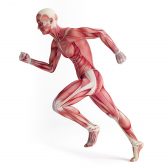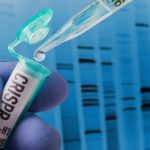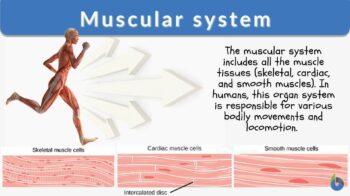
Muscular system
n., [ˈmʌ.skjʊl.ə ˈsɪstəm]
Definition: An organ system responsible for providing movement, heat, strength, posture, and balance
Table of Contents
Muscular System Definition
What is the muscular system? The muscular system is a system that includes muscle cells and muscle tissues. The human body’s muscular system consists of specific cells called muscle fibers. What is the muscular system function? The main function of the muscular system is the motor function. By the contraction of muscle fibers, it helps the body to perform daily activities. However, not only the human muscular system is responsible for the motor function in the body, but it is connected with other organ locations in the body in other systems, such as bones in the skeletal system. So, the skeletal and the muscular systems are integrated systems in the motor function. How many muscles are in the human body? There are 600 in the human body and there is no difference between the female muscular system and the male system regarding the number of body muscles. The main muscle groups are chest, back, shoulders, legs, and arms.
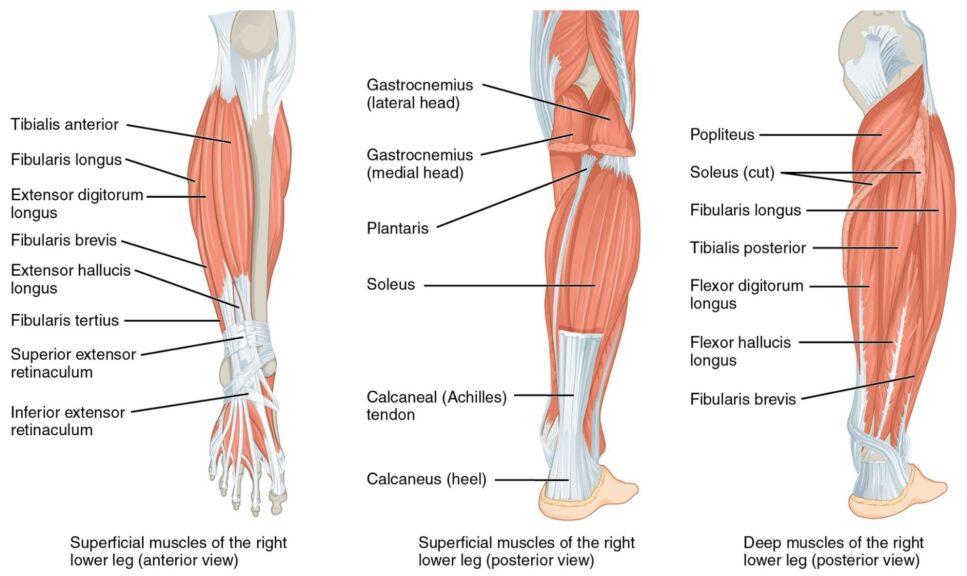
The muscular system is an organ system responsible for providing strength, keeping up the balance, maintaining posture, allowing movement, and producing heat. It includes all the muscle tissues, such as the skeletal muscle tissues, smooth muscle tissues, and cardiac muscle tissues. The skeletal muscles are muscles attached to the bones and are responsible for the voluntary movements of the body.
Example of the Muscular System
What is the muscular system structure? There are three types of muscles in the body as follows:
- The skeletal muscles: what is a skeletal muscle? skeletal muscles are attached to bones by tendons. The musculoskeletal system is the most convenient term to describe this connection. They are voluntary muscles which means that they are under the conscious control of the human. Skeletal muscles are called striated muscles because of the striations (line formations) as seen under the microscope. The human body has more than 600 skeletal muscles, which make up about 40% of a person’s body weight.
- Smooth muscles: Smooth muscles are mainly found in the body’s internal structures such as the digestive tract and blood vessels. Unlike skeletal muscles, smooth muscles are involuntary muscles.
- Cardiac muscles: cardiac muscles are specialized cells; they are found in the heart only. Like smooth muscles, cardiac muscles are involuntary muscles that cannot be controlled by our consciousness. The cardiac muscle stimulates itself in order to form a heartbeat.
Muscle disorders may affect the muscle or nerves and neurotransmitters surrounding the muscle. Examples of muscle diseases are multiple sclerosis, myopathy, muscle dystrophy, and peripheral neuropathy.
Muscular System Anatomy
The functional unit of the muscular system is the muscle.
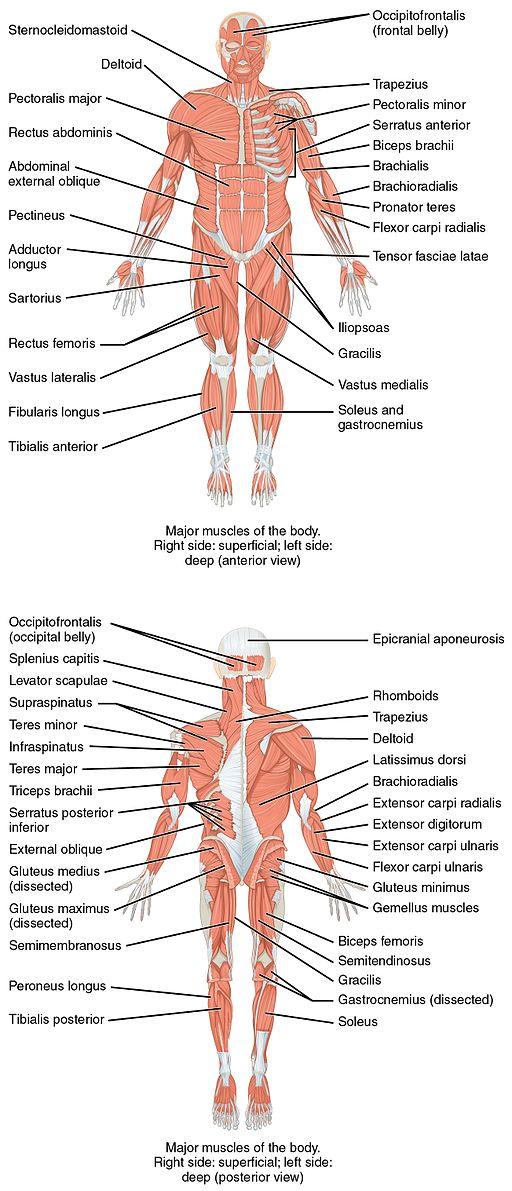
Muscles
What are the main parts of the muscular system? There are three types of muscles in the muscular system along with skeletal system bones. Anatomically, muscular system organs are described as:
Skeletal muscle
The muscles of the skeleton have muscle tissues that are associated with other various tissues, such as vascular tissues, connective tissues, and nerve tissues. The main difference between muscles of the muscular system is the anatomy of each muscle fiber. This variation may be in the size where some muscles are large such as muscles of the thigh while others are tiny such as those found in the middle ear “stapedius muscle”. Muscle fibers may also vary in shape so they may be broad or narrow, in the arrangement of fibers where some are parallel to the long axis of muscle or oblique.
The muscular system consists of the muscle fibers which are covered by a connective tissue sheath called the epimysium. Human muscles are separated into compartments consisting of bundles of muscle fibers. Each bundle is covered by another connective tissue called perimysium. The main function of connective tissue covering muscles is to support and protect the muscle to bear the contraction force. As well as providing a pathway to allow the passage of blood and nerves to each muscle.
Cardiac muscle
The heart is one of the major muscles of the body, it consists of cardiac muscles only called the myocardium. Cardiac muscles are involuntary muscles, they have rhythmic contraction controlled by the sinoatrial node in the heart. Cardiac muscles consist of chains of myofibrils. As such, the cardiac muscles contract continuously. Cardiac cells are rectangular in shape and have only one central nucleus. They also contain lots of mitochondria to form ATP and myoglobin to produce and store oxygen to provide energy to muscles in order to resist fatigue. Each cardiac cell is covered by a barrier between the extracellular and intracellular content called the sarcolemma.
Smooth muscle
Where is smooth muscle found? Smooth muscles represent parts of the body’s internal organs. It is mainly found in the gastrointestinal tract as well as blood vessels. Smooth muscle location varies, as they may be found in other sites such as renal, genital, and respiratory tract. Their function differs according to their location. For example, in the respiratory tract and the cardiovascular system, the function of the smooth muscle is to control the diameter of bronchioles in the respiratory tract and blood flow as well as pressure in the cardiovascular system.
Smooth muscles are non-striated involuntary muscles. These muscles maintain their tone for long periods of time. The main proteins responsible for their contraction are the thick, dark myosin filaments and thin, light actin filaments. Smooth muscles have a particular shape which is fusiform, as they have tapered ends. Being non-striated muscles, smooth muscles are more elastic than striated muscles. So, they can keep the contractile tone for a long time as keeping the tone of the urinary bladder.
Gross anatomy of a skeletal muscle
Muscle fibers are the main components forming the skeletal muscle. Skeletal muscles have thousands of muscle fibers that are united in bundles or fascicles.
Anatomically, each skeletal muscle consists of the following:
- Each muscle fiber is covered by a connective tissue called the endomysium.
- A group of muscle fibers called Fasciculi is covered by connective tissue with elastin known as the perimysium.
- A group of fasciculi forms the muscle covered by epimysium, which is a dense connective tissue. These connective tissues play an important role in facilitating muscle contraction. Skeletal muscles are attached to the skeleton “bones” by tendons. Tendons are tough connective tissues that connect the muscles and the bones. They are under extreme stress when muscles pull on them as the muscles shorten their lengths.
There are different subtypes of skeletal muscles depending on the attachment of muscle fibers as follows:
- Longitudinal muscles: muscle fibers are attached in a parallel manner such as fusiform like biceps or strap-like rectus abdominis.
- Pennate muscles: muscle fibers are attached in an oblique manner to the tendon such as unipennate like soleus muscle or bipennate like rectus femoris muscle or multipennate like a deltoid muscle.
- Convergent muscles: like temporalis muscle
- Circular muscles: such as orbicularis oculi.
Names of skeletal muscles
- Location: the location of the muscle according to the nearby bone is important to give its name. such as the temporalis muscle which surrounds the temporal bone. The Frontalis muscle is found on the top of the frontal bone of the skull.
- Shape: muscle can be described by its shape. Such as the deltoid muscle which is triangular, Trapezius which is trapezoid in shape is one of the muscles of the back, and Serratus which is like saw-toothed.
- The direction of muscle fibers: As parallel muscles are rectus, such as in rectus abdominals, Oblique muscle fibers are at an angle, such as the abdomen muscles, and Transverse fibers are perpendicular.
- Size: Some suffixes may be included in muscle names such as maximus (largest), minimus (smallest), Longus (longest), and Brevis (shortest). For example, the gluteus maximus is the biggest muscle in the body.
- Position: muscles may be given the name by the position according to the midline. Lateralis means that muscle is away from the midline. Medialis means that the muscle is near the midline.
- The number of origins: the number of muscles in the group can be included in the name of muscles. Biceps, triceps, and quadriceps have two, three, and four muscles respectively.
- Action: some terms of action are prefixes in muscle names. For example, flexor means flexing the arm, extensor means extending the arm, abductor means to move the arm out of the torso, and adductor means to return the arm back to the torso.
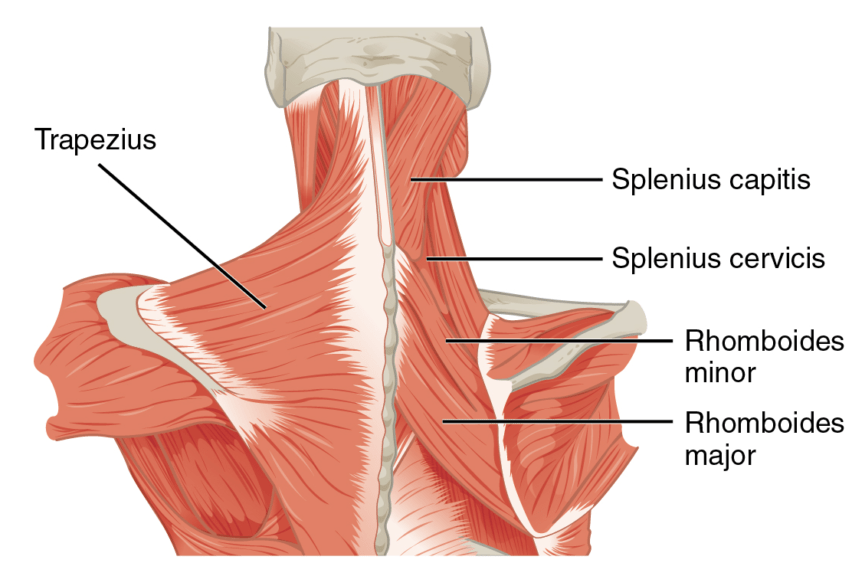

Group actions in skeletal muscle
Skeletal muscular system parts are attached to the bone at each end, the movable end of the muscle is connected to a site of the bone called the muscle’s insertion. While the other end of the muscle is connected to the fixed bone known as the origin. During movement, many muscles participate in the same movement. But there is a fundamental muscle in the action, which is referred to as prime mover. The prime mover is called agonist, there is another muscle called synergist that helps the prime mover to initiate muscles movement. A synergist may be a fixator that makes the bone stable. On the other hand, there are muscles that are apposite the primary action of the muscle, these are called antagonists. Antagonist muscles are important to maintain the body’s position like holding the arm.
Skeletal muscle histology
Histologically, skeletal muscles consist of muscle fibers, which appear under the microscope as Units. Each unit consists of the fusion of single cells. They appear as elongated cylindrical, multinucleated units. The muscle fiber diameter ranges from 10 to 100 micrometers. additionally, the length of the fiber may reach 35 cm. The nuclei of fibers are flat and outward of the muscle fiber. The sarcoplasm of muscles has myofibrils consisting of proteins responsible for the contraction of muscles. Myofibrils are arranged in repeated units forming light and dark appearances of cross striation under the microscope.
Sarcomere structure
The sarcomere is the main functional unit of the muscle. Each sarcomere consists of two types of protein filaments called myofilaments: actin protein, which is the thin filament, and myosin, which is the thick filament. Under microscopic examination, the sarcomere is divided into four bands. A band is a dark-colored area consisting of myosin. I band is a lighter-colored area consisting of actin. Z line is a dark central line formed from actin and myosin overlapping giving the muscle its striated appearance. H zone is lighter in color and is located at the center of the sarcomere.
Muscular System Diagram
Here is the diagram of the human muscular system:
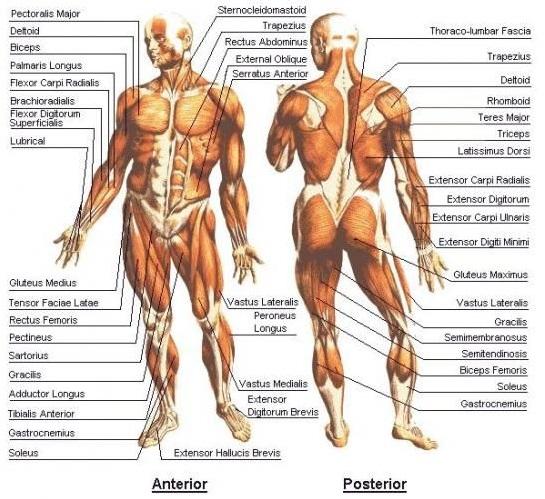
Muscular System Physiology
Find out about the functions of the muscle tissues below.
Functions of muscle tissue
What is the main function of the muscular system? muscle tissue function is mainly body movement. However, it has many important roles in the human body such as:
- Body’s Movement: through the connection between muscles and bones “skeletal system”.
- Maintenance of the posture.
- Respiration: smooth muscles in the airway maintain normal respiration.
- Generation of heat: since muscle contraction generates heat.
- Blood flow to body organs: smooth muscle located in blood vessels controls the blood flow.
- Pumping the blood: cardiac muscles in the heart pumps the blood to vessels.
- Facial expressions: facial muscular control our expressions showing our emotions.
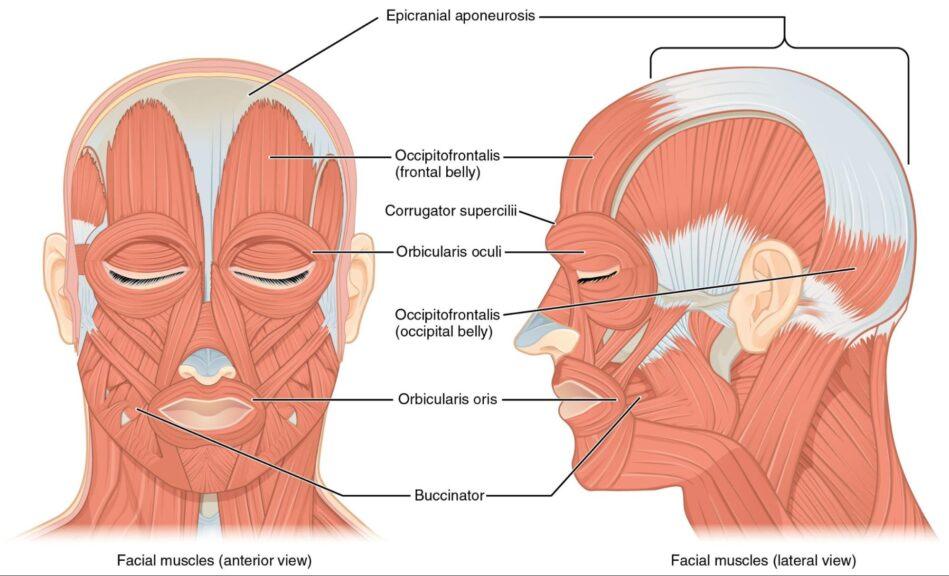
Skeletal muscles as levers
Skeletal muscles act as levers for the body. One of the most efficient examples is the synovial joint movements. Each joint is affected by three forces, effort, fulcrum, and load. Consequently, there are three types of levers according to the three forces. The first class is when the effort and the load are in the same direction and opposite to the fulcrum as atlantooccipital joint in the head muscles and neck muscles. The second class of levers is in the lower legs when the calf raises the effort raises from the gastrocnemius muscle, which is connected to the calcaneus bone, and the effort is much bigger and opposite to the load while the distance between the load and the effort is away from the fulcrum. The third class is as in the elbow joint, where the distance between the fulcrum, which is at the elbow joint, and the effort which is at the insertion of the muscle “biceps” is very small. Therefore, the bicep makes more effort than the calf raises to bear the same weight.
Motor units
Each muscle fiber is connected to neurons called somatic neurons. Neurons are branched from the grey matter in the spinal cord, they have electrochemical substances known as neurotransmitters. Each neuron targets a specific muscle where the neuron axon enters the targeted muscle and the neuron branches to small branches into the muscle. neuron branches reach the midpoint of the muscle fiber where the axon finally splits leading to the formation of the cluster of terminal branches. Each terminal axon has neurotransmitters secreted into the neuromuscular junction which is the distance between the muscle and the terminal of the neuron axon. the main neurotransmitter in the neuron axon is acetylcholine. The motor unit is the branch of a neuron targeting a specific group of muscle fibers. The size of a motor unit depends on the number of fibers connected to the nerve.
Contraction cycle
The contraction cycle starts with the neuron signals (nerve impulses) from the spinal cord which leads to the release of calcium. The calcium activates the synaptic pump to release acetylcholine. Acetylcholine in the junction attaches to acetylcholine receptors in muscle fibers, then the muscle is in an excitation state. In this state, muscle actions are done according to the cross-bridge cycle through the connection between the head of myosin filaments and actin filaments. The most important component is ATP since ATP attaches to myosin first raising the energy state of myosin. Consequently, ATP hydrolysis to ADP and phosphate. Due to the hydrolysis of ATP, myosin is ready to attach to actin filaments. On other hand, calcium attaches to other proteins called troponins, this attachment exposes the site of attachment in actin filaments. The attachment process is known as the power stroke state where the sarcomere shortens. Then, the myosin is low in energy and ATP plays an important role in the separation of the myosin and actin at this point. Therefore, ATP has a role in the contraction and relaxation of the muscle. When the muscle is in a resting position, the regulatory proteins tropomyosin and troponin block the myosin-binding sites on actin filaments.
Types of muscle contraction
There are different types of muscle contraction:
- Isotonic: it is the contraction at which the muscle length changes
- Concentric: where the muscle gets shorter during contraction. the force here is much greater than the resistance which leads to the shortening of sarcomere and muscle contraction.
- Eccentric: The muscle gets longer by generating force. Unlike Concentric, the resistance is much bigger than force where the sarcomere and muscles lengthen.
- Isometric: the length of the muscle is not affected whereas the contraction generates force. It is also known as yielding or overcoming.
- Yielding: it is the contraction at which the force is opposed by resistance. As when holding heavy weights without changing their position
- Overcoming: it is the contraction at which the force is opposed by immovable force. As pushing the wall.
Functional types of skeletal muscle fibers
There are two types of muscle fibers:
- Type 1: since they have many mitochondria to make aerobic respiration, many capillaries, and a lot of myoglobin to deliver the oxygen easily. These fibers are slow oxidative fibers that depend on aerobic respiration to produce ATP. These fibers are slowly fatigued. Therefore, they can be found in positions that do not require high tension, fast movement, or high energy movement.
- Type 2: it is divided into two types:
- Type 2 A, which are considered fast oxidative fibers that depend on aerobic or sometimes anaerobic respiration. ATP in those fibers is produced more quickly. So, these fibers are able to produce more tension than others.
- Type 2 B, which are fast glycolytic fibers depending on anaerobic glycolysis. It has the least amount of myoglobin and mitochondria. It is the least type of fiber that can bear fatigue.
Muscle metabolism and fatigue
Muscle metabolism is a process that produces energy responsible for contraction. Glucose in the blood is stored as glycogen in muscles. When the muscle needs energy, the stored glycogen is converted into glucose. Aerobic respiration occurs in the presence of oxygen and glucose produces ATP and CO2 in the final step. Anaerobic respiration takes place in absence of oxygen and glucose metabolism produces lactic acid in the blood. Lactic acid causes muscle cramps.
Clinical Significance
There are two main clinical significances to muscle Architecture which are:
1- Motor function: the architecture of muscle is very specific to its function in its position. The signal from the brain “central nervous system” is crucial for movement, but the muscle makes the actual action by its anatomical design.
2- Surgical muscle-tendon transfer: it is important to understand and study the human muscle anatomy in many fields such as the surgical field. Since tendons can be transferred from one muscle to another, therefore, the architecture of both muscles is important as the donor muscle must have the same architecture and function as the receiver muscle.
Try to answer the quiz below to check what you have learned so far about the muscular system.
References
- 10.7 Myocardial tissue—anatomy and physiology. OpenStax. (n.d.). https://openstax.org/books/anatomy-and-physiology/pages/10-7-cardiac-muscle-tissue
- Anatomy and physiology. Types of Muscles. (n.d.). https://www.cliffsnotes.com/study-guides/anatomy-and-physiology/muscle-tissue/types-of-muscles
- Boundless. (n.d.). Boundless Biology. Lumen. https://courses.lumenlearning.com/boundless-biology/chapter/muscle-contraction-and-locomotion/
- Encyclopædia Britannica, inc. (n.d.). Humane muscle system. Encyclopædia Britannica. https://www.britannica.com/science/human-muscle-system
- Feger, J. (2021, December 28). Skeletal muscle: Radiology testimonial article. Radiopaedia Blog RSS. https://radiopaedia.org/articles/skeletal-muscle?lang=us
- Hafen, B. B. (2021, July 19). Anatomy, smooth muscle. StatPearls [Internet]. https://www.ncbi.nlm.nih.gov/books/NBK532857/
- Histology-skeletal muscle. Pathology Outlines – Histology-skeletal muscle. (n.d.). from https://www.pathologyoutlines.com/topic/softtissueskeletalnormal.html
- Introduction to the muscular system. Introduction to the Muscular System | SEER Training. (n.d.). https://www.training.seer.cancer.gov/anatomy/muscular/
- Libretexts. (2020, August 14). 9.6D: Muscle attachment sites. Medicine LibreTexts. https://med.libretexts.org/Bookshelves/Anatomy_and_Physiology/Book%3A_Anatomy_and_Physiology_(Boundless)/9%3A_Muscular_System/9.6%3A_Overview_of_the_Muscular_System/9.6D%3A_Muscle_Attachment_Sites
- Motor units in skeletal muscle. GetBodySmart. (2020, April 21). https://www.getbodysmart.com/muscle-fiber-nerve-supply/motor-units
- Muscle Fibre types. Physiopedia. (n.d.). https://www.physio-pedia.com/Muscle_Fibre_Types
- Muscles. Muscle – Better Health Channel. (2012). https://www.betterhealth.vic.gov.au/health/conditionsandtreatments/muscles
- Muscles-structure and function. FUNCTIONS AND PROPERTIES OF MUSCLE TISSUES. (n.d.). https://content.byui.edu/file/a236934c-3c60-4fe9-90aa-d343b3e3a640/1/module7/readings/function_muscle_tissue.html
- Parent, D. (n.d.). Biomechanics: Lever Systems in the body. Visible Body 3d Human Anatomy. https://www.visiblebody.com/blog/biomechanics-lever-systems-in-the-body
- Sarcomere. Sarcomere – an overview | ScienceDirect Topics. (n.d.). https://www.sciencedirect.com/topics/neuroscience/sarcomere
- Saxton, A. (2021, August 11). Anatomy, thorax, cardiac muscle. StatPearls [Internet]. https://www.ncbi.nlm.nih.gov/books/NBK535355/
- The *Veterans Affairs Medical Center and University of California Departments of Orthopaedics and Bioengineering. (n.d.). The clinical significance of skeletal muscle structure: clinical orthopaedics and related research®. LWW. https://journals.lww.com/clinorthop/Fulltext/2001/02000/Clinical_Significance_of_Skeletal_Muscle.16.aspx
- University, R., & OpenStaxCollege. (2013, March 6). Naming skeletal muscles. Anatomy Physiology. https://pressbooks-dev.oer.hawaii.edu/anatomyandphysiology/chapter/naming-skeletal-muscles/
©BiologyOnline.com. Content provided and moderated by Biology Online Editors.



